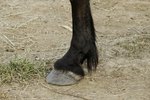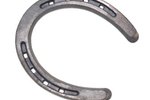Back in the old days -- most of the 20th century -- a horse diagnosed with a deep digital flexor tendon injury was likely kept stall-bound for up to year as a primary therapy. Today, a lay-up is still necessary, but equine veterinary science employs various sophisticated treatments for this serious, often-career changing injury.
Deep Digital Flexor Tendons
The flexor tendons are situated in the hind legs, and consist of the superficial digital flexor tendon and the deep digital flexor tendon. Both are sited along the cannon bone, with the former going into the pastern bone and the DDFT reaching the coffin bone. Both of these tendons include a check ligament, with the upper check attaching to the SDFT and the lower one attached to the DDFT. The ligaments and tendons support the leg.
Besides lameness, evidence of a problem with the DDFT includes swelling and heat. While any horse can develop a DDFT injury, it's most common in horses working at speed, such as racehorses and jumpers.
Initial Treatment
If you suspect a DDFT injury, call your vet. She may tell you to hose the affected leg in cold water for about 15 minutes or so. If you have ice boots, that's another option. Your vet might advise you to wrap the leg for support, and might also prescribe anti-inflammatories. The hosing and medication continue for at least a week. For the vet to accurately diagnosis your horse's lameness, you must bring him to an equine clinic or hospital where she can ultrasound the leg. Even better, though not always available, is magnetic resonance imaging. Once you know exactly what you're dealing with, your treatment options broaden. One caveat: They aren't cheap.
Therapeutic Shoeing
Your farrier, working with your vet, may change your horse's shoeing to ameliorate the DDFT. He might shoe your horse with a rockered or rolled toe, which helps the breakover of the foot.
Therapy Options
If you have an equine hospital nearby, it probably offers extracorporeal shock wave therapy. The increased blood flow to the injury stimulated by the shock waves hastens healing. IRAP -- interleukin-1 receptor antagonist protein -- is another available option. The vet draws a blood sample from your horse, then incubates the sample with the use of specialized glass beads, eventually growing the IRAP. The horse is then injected with the IRAP in the injured tendon.
Stem Cell Therapy
Stem cell therapy may soon be widely available for the treatment of a DDFT injury. While equine vets already use stem cell therapy for treatment of certain superficial flexor tendon lesions, the use of these mesenchymal stem cells for DDFT issues is undergoing clinical trials. The cells, taken from bone marrow, are injected into the injury location. Another DDFT treatment entails a bone marrow transplant, with marrow extracted from the horse's own sternum and placed in the injured area.
References
Writer Bio
Jane Meggitt has been a writer for more than 20 years. In addition to reporting for a major newspaper chain, she has been published in "Horse News," "Suburban Classic," "Hoof Beats," "Equine Journal" and other publications. She has a Bachelor of Arts in English from New York University and an Associate of Arts from the American Academy of Dramatics Arts, New York City.





